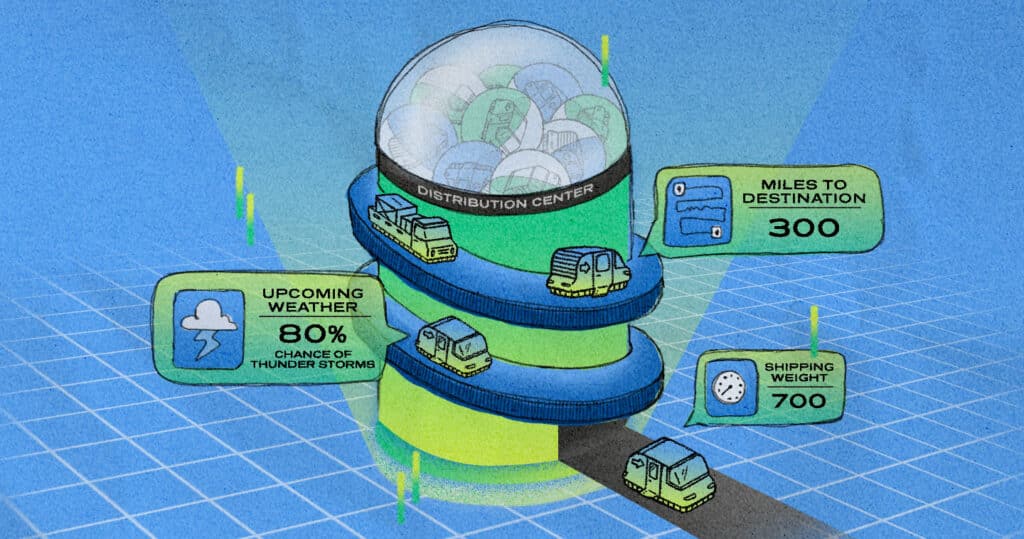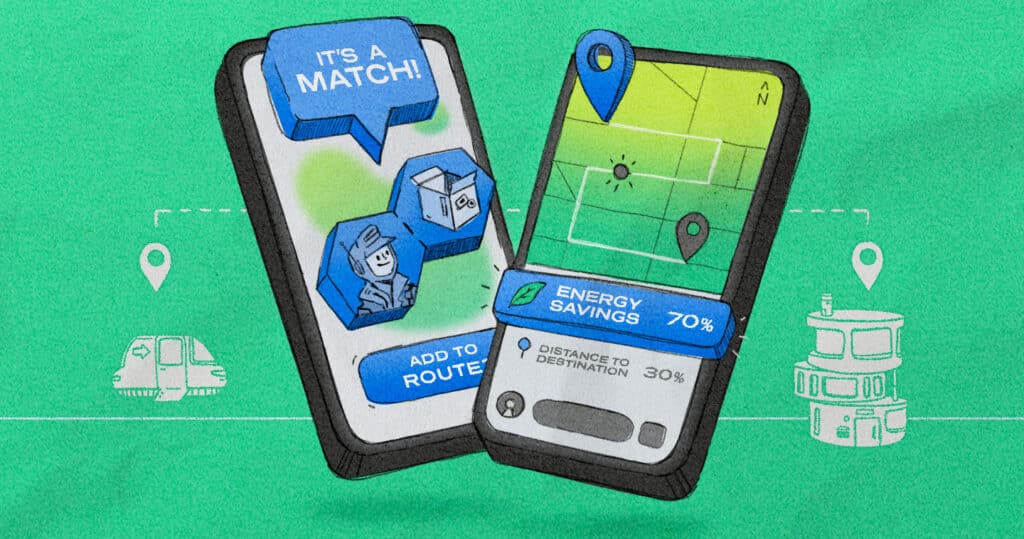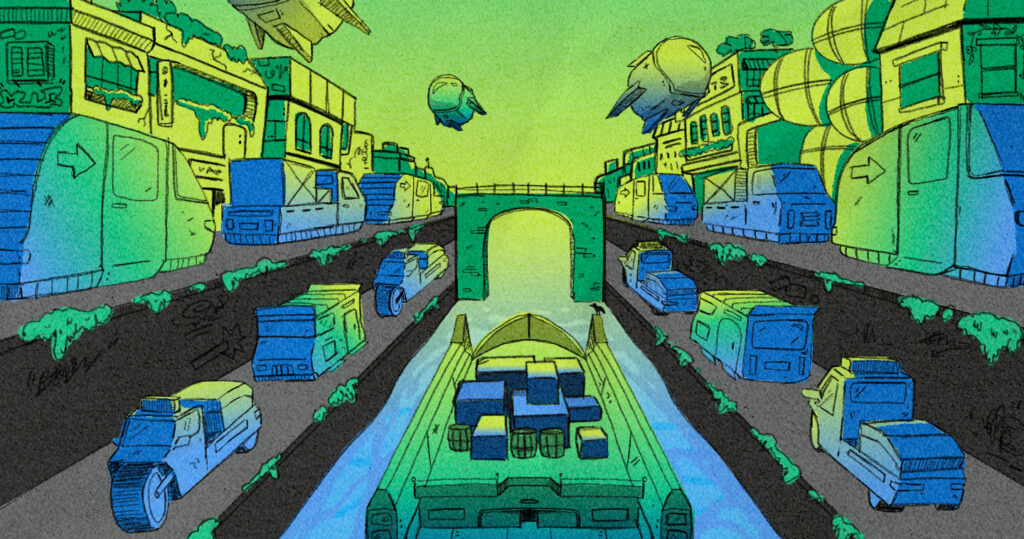The global supply chain accounts for some 80% of global emissions, according to the World Economic Forum. Raw materials, agricultural products, and high-end consumer goods crisscross the globe, so every kilogram of C02 saved is a win for climate action.
While it’s exciting to imagine a Solarpunk future of green hydrogen tankers and electric aircraft, optimization and efficiency are equally important in drawing down emissions, and data drives these transformations. From optimizing routes to determining how to decarbonize a fleet, data is at the center of every decision for businesses big and small.
At scale
Global companies, the kinds that ship millions of products all over the world, are uniquely positioned to add sustainability to the transportation industry’s main focuses of speed and cost. But, without a way to talk about the impact and benefits of optimization, it can be hard to know where to start or what will make the greatest impact. Without that vision, it can be hard to get buy-in from stakeholders, too. This is why data is so valuable.
“Data is undeniable,” said Mahek Naresh Oberai, a staff industrial engineer of global supply planning at Western Digital, “when someone shows you the numbers, it shows accountability and impact.”
Oberai works on optimizing the global supply chain for Western Digital, trying to find efficient, sustainable ways to get hundreds of thousands of products from manufacturing sites to a global consumer base. Thanks to the work of Oberai and her colleagues, Western Digital has reduced its supply chain’s annual C02 emissions by more than 250,000 metric tons since 2020.
To do this, Oberai and her colleagues collect data from the company’s transportation management software including the origin, destination, weight, and length of trip. Using this data, they can estimate climate impact, and break it down by manufacturing location, product type, consumer market, and more. This data is combined with predictive AI, which seeks to account for challenges like supply shortages or severe weather, to help flesh out Western Digital’s impact.

On top of the data, Oberai and her team also leverage the 4IR capacities of Western Digital’s Global Lighthouse facilities, to gain a clear understanding of operations all over the world, down to the lights on in the breakroom. This insight provided a new, more precise way to talk about climate impact at Western Digital.
“Early on, someone reached out to me and wanted to understand the impact of using air versus ocean, and why we don’t do more air shipping,” Oberai said. “Previously we had no way of answering that question, but with emissions data, we can.”
“It’s an important mindset change,” she said.
The emissions data also helps outline the ESG goals for Western Digital, too. Oberai believes that support for those goals company-wide comes, in part, from data that helps every business unit understand the company’s climate impact, and how to drive climate action.
“It’s important to sow this seed of data, to nurture it,” she said, “because of our hard work, we’re an influential customer and partner in the ESG space.”
Small business, big impact
It’s not just the global enterprises that will have an impact, though. The WEF estimates that some $50 billion dollars must be directed to decarbonize small and medium-sized businesses in the supply chain.
This will prove tricky because smaller businesses lack the resources and influences that benefit their larger counterparts; unique solutions are required for unique problems. Shuddl, a San Diego-based start-up, is aimed at addressing one aspect of this challenge: the immense waste of half-full freight trucks.
“We saw all this waste in the shipping industry, not just money but emissions, too,” said Spencer Steliga, founder and CEO of Shuddl. “We found that 54% of freight trailers aren’t full, so we are finding ways to prevent that waste.”
Shuddl uses data to notify drivers of additional shipments on their route they can pick up for additional pay. The idea is that by piggybacking these less-than-truckload shipments on already chartered trucks, the drivers make a little money and there’s less carbon spewed into the air. To do this, Shuddl uses data and AI to create models for logistics hubs to match shipments with drivers.

“We create a baseline for a city based on about 14 data points, and then the AI model grows from there,” Steliga said, “This has really only become possible for a company our size in the last year with the advancements in AI.” While some climate start-ups are looking for moonshots, Shuddl is focused on quick wins with immediate impacts.
“We can see we have all this business in Dallas, and we see that a city like Atlanta has similar freight habits. With AI we can quickly create a baseline model, test it in the real world, and then grow it from there,” said Steliga. “Even if we make a mistake, we can take that financial hit, and our model corrects for it in the future.”
The endeavor is not without its challenges, though. Steliga’s business is largely built upon access to data from the shipping industry, an asset that is jealously guarded. So far, Shuddl’s models have been based on data it collects from drivers and shipments directly.
“Data transparency is something I’m big on. Sharing that data would make everybody stronger, so why guard it,” said Steliga, “Why make it harder for everyone?”
Moving forward
Innovation and technology are an important part of climate action, but unless we all speak the same language, it will be hard to make any progress. Steliga believes that data will lay the foundation for a global carbon accounting ledger, powered by the blockchain. But that’s only possible with transparent discourse about what we know in a shared language. Data is that language and can lead us to better understanding and collaboration.
“Five years ago, we couldn’t have come up with the ESG goals that we have today. You need to understand where you are before you can get anywhere,” said Oberai.
“That’s why data is so important.”
Artwork by Rachel Garcera



